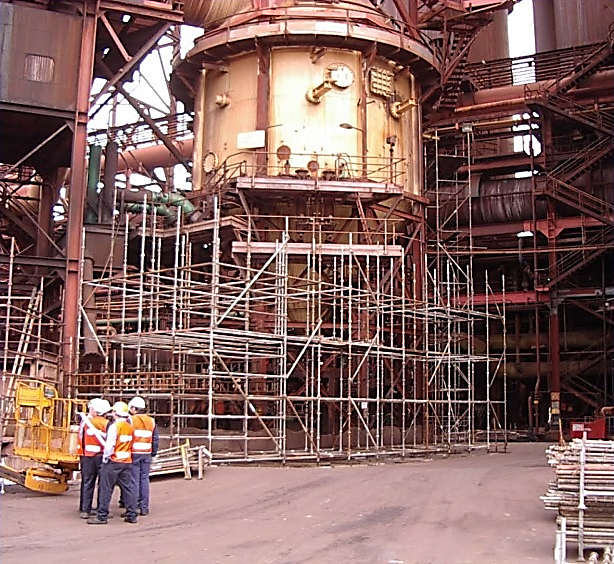| Project | VEF for venturi scrubbers |
|---|---|
| Target | Extended life for venturi scrubbers. |



Photo description
The scrubber prior to blasting and coating.
Visible perforations seen after initial blasting.
A view of the externals of the venturi scrubber
Customers and industries
Steelmaking industry, Australia.
Target equipment
Blast furnace gas scrubber
Target Item
Venturi scrubbers.
Coating period
1995 - 2003.
Scope of work
Starting in 1995, the bottom of the scrubber was repaired and protected.
Subsequent shutdowns up to 2003 saw the entire internal lining replaced.
Subsequent shutdowns up to 2003 saw the entire internal lining replaced.
Materials used
Polyglass VE & VEF.
Corroglass 602 and Corroglass laminating resin.
Corroglass 602 and Corroglass laminating resin.
Coating process
■Grit blast internally to SA 3.
■Wash to reduce Metallic Salts.
■Pitfill with Corroglass 602 & repaired with 600g quadriaxial glass fibre laminating fabric.
■Apply Polyglass VE/VEF to a minimum dft of 1.5mm.
■100% Spark tested and thickness checked.
■Wash to reduce Metallic Salts.
■Pitfill with Corroglass 602 & repaired with 600g quadriaxial glass fibre laminating fabric.
■Apply Polyglass VE/VEF to a minimum dft of 1.5mm.
■100% Spark tested and thickness checked.
Merits of this application
Prior to Corrocoat Engineering Victoria’s involvement in 1995, this critical pressure vessel required patch weld repairs every six months,
necessitating regular scrubber shutdown periods to combat corrosion which was causing through-plate perforation and leaking.
Corrocoat Engineering Victoria first treated the vessel in 1995,
and subsequent inspections have shown these original areas of repair to be intact and corrosionfree.
Repairs carried out between 1995 and 2003 have now resulted in the coating of the entire internals of the pressure vessel – a total in excess of 200m2. Without
Corrocoat protection, it would by now have been necessary to replace the entire base of the blast furnace venturi scrubber.
necessitating regular scrubber shutdown periods to combat corrosion which was causing through-plate perforation and leaking.
Corrocoat Engineering Victoria first treated the vessel in 1995,
and subsequent inspections have shown these original areas of repair to be intact and corrosionfree.
Repairs carried out between 1995 and 2003 have now resulted in the coating of the entire internals of the pressure vessel – a total in excess of 200m2. Without
Corrocoat protection, it would by now have been necessary to replace the entire base of the blast furnace venturi scrubber.
Corrocoat Japan credentials etc
The effectiveness of the Corrocoat methods and materials has negated the need for replacement and extended the working life of the scrubber.
The success of this project has led to the customer specifying Corrocoat systems to protect other areas of plant including a further scrubber and other blast furnace gas handling systems such as precipitators.
The success of this project has led to the customer specifying Corrocoat systems to protect other areas of plant including a further scrubber and other blast furnace gas handling systems such as precipitators.
